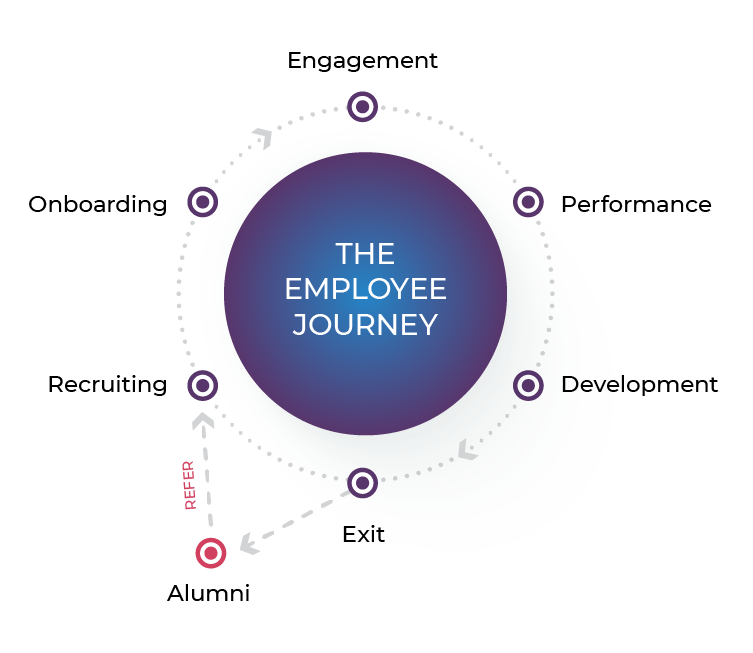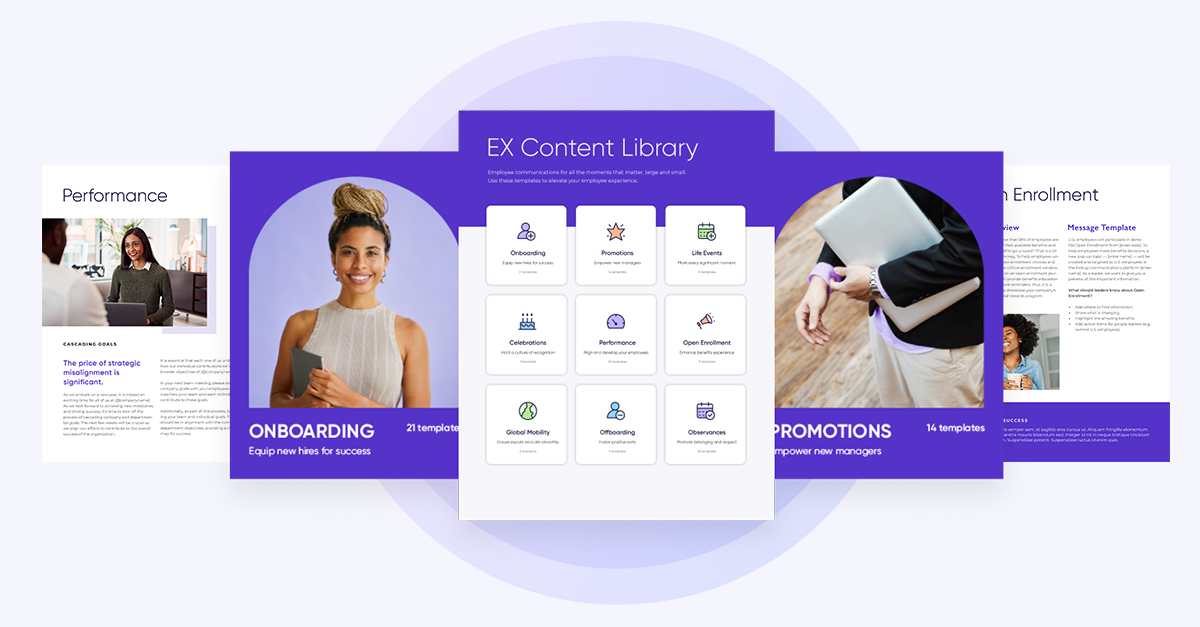Remember a few years ago, when every company was calling itself “customer-centric?” Well, times and business objectives have changed, and all those “customer-obsessed” organizations are now becoming “employee-obsessed,” because they’ve recognized that the employee experience directly affects their business outcomes. How productive, effective and engaged people are at work directly affects everything from workplace culture to profits to growth.
So how do companies know if their employee experience is positive or negative, working or failing? Is there a way to measure and evaluate it? And most importantly, how can your company improve on its employee experience efforts? If you’ve got questions, we’ve got answers.
- What is Employee Experience →
- Digital Employee Experience vs Physical Employee Experience →
- What is the difference between employee engagement and employee experience? →
- Why is employee experience so important? →
- How to measure the impact of employee experience →
- How to improve the employee experience →
What is Employee Experience (EX)?
The definition of employee experience is the sum total of a worker’s experiences at a company. It covers their cultural experiences, such as interactions with coworkers, leaders and HR, their user experiences with workplace technology, and even their experiences with their workspace or environment.
Just as customer experience (CX) is the catch-all term that covers all consumer experiences with a brand, EX covers any and all employee experiences at an organization. Essentially, employees are now seen as the “customers” of an organization. This is particularly true in departments that are responsible for elements of company culture, like communications, HR and IT.
Although employee experience is a broad umbrella term, there are 5 key factors that influence it:
Interactions with management
Perhaps no other relationship impacts an employee’s experience as much as the one with their manager. A study by Gallup found that managers account for 70% of the variance in employee engagement. Great managers can serve as mentors or coaches, giving employees passion for their work and inspiring them to be more productive.
Team interactions
Team dynamics also play an outsized role in employees’ day-to-day work lives. Workgroups with positive dynamics that offer an environment of trust make it easier for people to bond, which in turn enables employees to work better together and be more productive. This environment of psychological safety can also increase creativity and lead to innovation.
The open-source Atlassian Team Playbook offers multiple ways to evaluate team health; Dominic Price, the company’s resident work futurist, explained how it works at our recent Attune Digital Employee Experience Summit.
Interactions with the company
Not every employee will interact with their organization every day, but the interactions they do have can significantly impact how engaged they are. Consider the average CEO town hall—attendance may be mandatory, but the quality of the presentation will impact how employees feel about the company, and whether or not they’ll engage with future leadership events or communications.
The same holds true for interactions with content from human resources or comms teams. The more the company creates 2-way communication in all of these channels of engagement—whether it’s business leaders taking questions at a town hall or a communicator opening up a post for comments—the more likely employees will feel heard and recognized.
The employee life cycle or employee journey
The employee life cycle, or ELC, refers to the sequential milestones the employee experiences at an organization. Some companies, including ours, call this the employee journey because it invites comparison to the customer journey companies use to design their customer experience.
The employee journey has 7 stages: candidates are recruited, onboarded, engaged, perform their role, are developed/promoted, and finally exit the company. Their exit turns them into company alumni, and the journey can become cyclical when company alumni rejoin the organization or refer new talent. The HR department typically “owns” the ELC, but many different leaders and managers can impact it at various touchpoints.

Interactions with technology
While the first four factors all relate to human interactions and workplace culture, the employee’s day-to-day personnel experience is just as impacted by their user experience with a company’s software, hardware, systems and applications. Together, these experiences are known as the digital employee experience, or DEX, and they are a critical predictor of employee retention rates. Gartner’s 2021 Digital Worker Experience Survey revealed that employees who are satisfied with their workplace applications are 2x more inclined to stay with their organization.
Digital employee experience vs physical employee experience
Because human factors are challenging to influence, companies that want to make immediate changes often focus on either the digital employee experience or the physical one.
How the digital employee experience impacts EX
Different employee roles have different digital experiences depending on where they work, what kind of workflows they have, and what kind of software they use. A desk worker engaging with dozens of company applications on their laptop is going to have a very different digital employee experience than a field agent who does all their work on their smartphone, or a factory worker who receives most company information on digital signage.
Studies show that these different experiences lead to different challenges. Desk workers are often overwhelmed, receiving a deluge of emails, pings and notifications, forcing them to context-switch as often as 400 times a day. They may also have to manually log into different systems to find information. Meanwhile, deskless workers often lack digital capabilities—in our recent survey of IT professionals, 72% of them admitted their deskless workers don’t have access to the same employee engagement tools their desk workers use. And, this number may potentially increase in 2021 due to the number of new technologies desk workers have adopted during the pandemic.
However, while the challenges for these roles differ, the results are the same: workers who are dissatisfied with their digital employee experience. 46% of employees currently report that they are not satisfied with their workplace applications.
Find out what it takes to build a positive digital employee experience and future-proof your business
How physical employee experiences impact EX
Physical environments and workspaces also have a significant effect on how employees feel at work. Maybe more of an effect than it would seem at first glance—according to Jacob Morgan, 4x best-selling author and founder of FutureofWorkUniversity.com, it makes up 30% of the employee experience. And according to research presented in the journal Science Direct: “Temperature, air quality, lighting and noise conditions in the office affect the work concentration and productivity. Numerous studies have consistently demonstrated that characteristics of the physical office environment can have a significant effect on behaviour, perceptions and productivity of employees.”
In 2017, Morgan recommended that organizations improve the employment experience by reevaluating their physical environments and floor plan design based on 4 criteria:
- Chooses to bring in friends and visitors
- Offers flexibility
- Organizations’ values are reflected
- Leverages multiple workspace options
But as the pandemic spread in 2020, physical work environments were one of the many things upended by it. Suddenly safety and separation took precedence over communal workspaces and social workflows. Many organizations abandoned the office entirely, opting for fully remote, work-from-home environments for their desk workers.
So now that the return to work is finally on the horizon, will the recommendations for the physical office change? Not as much as one might think. A 2021 survey of 1,500+ C-suite executives showed that companies are investing heavily in hybrid workforces and workspaces, including conference rooms with virtual connectivity, communal office space and unassigned office seating, giving employees more options to engage with work where and how they prefer.
Of course, the one group that won’t benefit from these improvements is deskless essential workers whose jobs cannot be done remotely. According to a recent article by NPR, companies like Ford and GM, whose businesses are heavily contingent on the production line, are exploring new ways to improve conditions for frontline workers, as is the United Auto Workers union.
Potential suggestions for the physical space include making factories more comfortable by adding air conditioning and redesigning breakrooms. Additional suggestions for improving the overall experience included support services, such as ordering dinner for employees’ families, as well as professional development and training opportunities.
What is the difference between employee engagement and employee experience?
Employee experience focuses on a worker’s entire experience during their lifecycle with the company, but employee engagement refers to how involved an employee is with their work. It covers elements of employee satisfaction, including how passionate workers are about their jobs, but it also refers to how aligned employees are with their organization, how committed they are to it, and how much discretionary effort they put into their work. Engaged employees understand their purpose within their company, how they fit in, and how they can help achieve business impact.
Want to learn more about engaging your workforce?
Why is employee experience so important?
Employee experience is obviously crucial to the employee journey, but its effects extend well beyond that, creating tangible impacts on organizational culture and business results. Performance, productivity and profitability are all influenced by the employee experience. Maybe that’s why nearly 80% of business leaders surveyed by Deloitte rated it either important or very important.
5 critical areas impacted by the employee experience
Employee engagement and employee satisfaction
The employee experience directly affects how engaged and satisfied employees are. When employees have a work experience that works well for them, their workflows are more streamlined and they can do their jobs more easily and effectively. Those with a positive employee experience are also more motivated to engage with their work, their team and their organization as a whole. That can take the form of putting in extra effort on the job, staying up to date with company news and/or seeking out better processes or ways of working.
This is why many employers and HR departments keep an eye on their employee engagement metrics. Some large enterprises have even gone so far as to create a chief employee experience officer role, which manages the staff experience for workers just as a CMO would for customers.
Talent recruitment
Today’s candidates aren’t just looking for lucrative jobs, but for meaningful work. As potential employers vet them, they too are vetting companies. Beyond company review sites like Glassdoor and anonymous workplace discussion apps, it’s common for prospective employees to scrutinize benefits, sustainability practices and diversity, equity and inclusion policies during the hiring process.
A positive employee experience and strong shared culture can create employee advocates across all these categories and platforms, attracting more candidates and giving companies more access to top talent.
Employee retention
Just as employee performance is judged from day one, employees are also evaluating their new company from the start of the onboarding process. Companies that are slow to grant access to the necessary systems, servers, tools and information their people need for work are reducing productivity and creating a negative impression from the start. Some studies have shown that as many as 40% of newly recruited employees leave their jobs within 6 months—something that makes the HR employee experience more challenging.
The Harvard Business Review has identified common reasons why people leave, including better opportunities for career development, culture challenges, salaries, job shifts, and supervisor relationships. All of these are facets of the employee experience.
Customer experience
The correlation between employee experience and customer experience (CX) is undeniable. According to Gallup, companies with highly engaged workforces outperform their competitors by 147% in earnings per share. Research from Glassdoor also supports this correlation, with the company stating that “on average, a 1-point increase in Glassdoor company rating is associated with a 1.3-point increase in customer satisfaction. Even marketing industry experts recommend that if brands want to improve their customer experience, they start by making improvements to their employee experience.
Profitability
When it comes to linking employee experience with business impact, the numbers don’t lie. Studies from an array of industry-leading consultancies, institutions and companies show clear links between EX, profitability and business success:
Statistics on employee experience (EX) and profitability
- Companies that score in the top 25% on employee experience report a 2x return on sales and nearly a 3x return on assets – IBM’s Smarter Workforce Institute
- EX leaders have 25% higher profits than competitors with poor EX – MIT
- EX leaders have 4x higher average profits, 2x higher average revenues, 40% lower turnover and 24% smaller headcount – Jacob Morgan for SHRM
- EX leaders beat out the average S&P by 122% – Accenture
- Disengaged employees can cost companies between $450 and $550 billion dollars a year – Gallup
Belonging drives engagement
How to measure the impact of employee experience
Employee experience can be measured and evaluated by several different KPIs:
Measure employee engagement across the company’s content channels and content streams. Information like clicks, views, time spent on page, and the number of shares are all indicators that employees are engaging with company information. It’s especially important to have analytics that measures team content and to give team managers access to the results.
Measure sentiment by running pulse polls with different employee groups or the entire workforce. These quick surveys with just a few questions can give you immediate insight into how employees feel about a specific topic. Advanced analytics capabilities can also mine employee comments for sentiment.
Measure response to key initiatives by tracking engagement with communications around them. Did employees watch the town hall about the new org changes? Are they opening notifications about it? These are examples of metrics to review.
Measure user experience by tracking adoption and usage of software. If most employees are not using a specific tool, app or system, odds are they’re not aware of it or it’s not working well for them.
Regardless of which KPI you choose, make sure you are measuring it with unified analytics. That means your analytics dashboard should be able to measure across every channel, touchpoint, enterprise system and device your company uses to communicate.
How to improve the employee experience
Need to make improvements to your EX? Don’t think of it as a major, overwhelming overhaul. Instead, break it down into incremental, manageable steps or tactics. Here are 3 you can use to get started.
1. Focus on performance management
Only 2 in 10 employees say their performance is managed in a way that motivates them to do their best work. One way to do that is to foster active listening skills among your managers. Another option is journey mapping using employee polls called pulse surveys. According to the Academy to Innovate HR, “These enable you to measure the mood and frustration levels of employees at different times during the day and while working on different tasks. This data can then be used to find points of improvement.”
2. Design an employee experience framework
Create an employee experience framework to set expectations throughout the employee journey. Determine how your company’s shared purpose and values will apply to all 7 stages of the life cycle, and then do the same for your employee experience strategy.
Employee Experience Strategy

3. Improve your technology
Make sure your digital employee experience is working for all your people. This doesn’t necessarily mean convincing IT to run out and buy a bunch of new apps—it often just means getting more use out of the ones you already have. Work with your IT department to find a way to seamlessly connect all the systems your organization uses, so your employees don’t have to toggle between tools all day long and your company can communicate with them across all channels.
4. Build a culture of transparency
That may sound challenging, but if you’ve implemented the right technology, it’s easy to create a digital source of truth that employees go to for all of their information. One way is to do that is to create a dedicated content stream for your CEO or senior leadership, where they can post updates or even informal video messages. Once you open this direct line of communication, though, make sure it goes both ways. Create avenues for your employees to give feedback, and for your company to act on it.
Conclusion: The employee experience calls for collective responsibility
The days when employee experience was only HR’s responsibility are long gone. Today the job of employee experience management also falls on C-suite leaders, internal communicators and IT professionals. By working together to shape company technology, culture and the physical workspace, they can become one of the elite 6% of organizations that are truly experiential.






